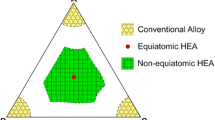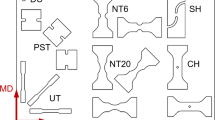Abstract
When alloys containing two ductile phases are heavily deformed, composite-like microstructures develop and strengths well in excess of either of the phases in single phase form may be exhibited as a result of microstructure/dislocation density effects. In this paper a previously-published model for such strengthening is reviewed, and its application in a predictive capacity discussed. Flow stressvs fabrication strain data for the two components in single phase form and for one two-phase alloy are necessary for this purpose. The model may then be applied to predict strength for any other two-phase alloy as a function of composition, fabrication strain, and interphase spacing. The approach is illustrated using existing data for several alloy systems. For Ag-Fe and Cu-Nb alloys (with very limited mutual solubility) strengths can be predicted within 15 to 20 pct of the experimental values over the entire range of strains and volume fractions for which data are available. In systems where the potential for precipitation hardening exists (e.g., Cu-Fe) thermal history is important. When such hardening becomes a significant factor, the model cannot be used in its present form due to uncertainty over how to “add” the strengthening from this effect. Such hardening may, however, be useful in further improving the properties of these materials.
Similar content being viewed by others
References
P. D. Funkenbusch, T. H. Courtney, and D. G. Kubisch:Scripta Metall., 1984, vol. 18, pp. 1099–1104.
G. Frommeyer and G. Wassermann:Acta Metall., 1975, vol. 23, pp. 1353–60.
H. P. Wahl and G. Wassermann:Z. Metall., 1970, vol. 61, pp. 326–39.
Gunter Wassermann:Z. Metall., 1973, vol. 64, pp. 844–48.
A. Kelly and R. B. Nicholson:Prog. Mater. Sci., 1963, vol. 10, pp. 151–391.
P. D. Funkenbusch and T. H. Courtney:Acta Metall., 1985, vol. 33, pp. 913–22.
J. Bevk, J. P. Harbison, and J. L. Bell:J. Appl. Phys., 1978, vol. 49, pp. 6031–38.
C. Liesner and G. Wassermann:Metall., 1969, vol. 23, pp. 414–17.
Metals Handbook, 9th ed., ASM International, Metals Park, OH, 1979, vol. 2, p. 242.
John Patrick Page: M.S. Thesis, Univ. of Tenn., Knoxville, TN, 1957.
P. D. Funkenbusch: Ph.D. Thesis, Michigan Technological Univ., Houghton, MI, 1984.
K. R. Karasek and J. Bevk:Scripta Metall., 1980, vol. 14, pp. 431–35.
J. Bevk and K. R. Karasek:New Developments and Applications in Composites, D. Kuhlmann-Wilsdorf and W. C. Harrigan, Jr., eds., TMS-AIME, Warrendale, PA, 1979, pp. 101–13.
W. A. Spitzig, A. R. Pelton, and F. C. Laabs: Ames Laboratory, Iowa State University, Ames, IA, unpublished research, 1986.
R. L. Fullman:Trans. TMS-AIME, 1953, vol. 197, pp. 447–52.
Author information
Authors and Affiliations
Rights and permissions
About this article
Cite this article
Funkenbusch, P.D., Lee, J.K. & Courtney, T.H. Ductile two-phase alloys: Prediction of strengthening at high strains. Metall Trans A 18, 1249–1256 (1987). https://doi.org/10.1007/BF02647194
Received:
Published:
Issue Date:
DOI: https://doi.org/10.1007/BF02647194




